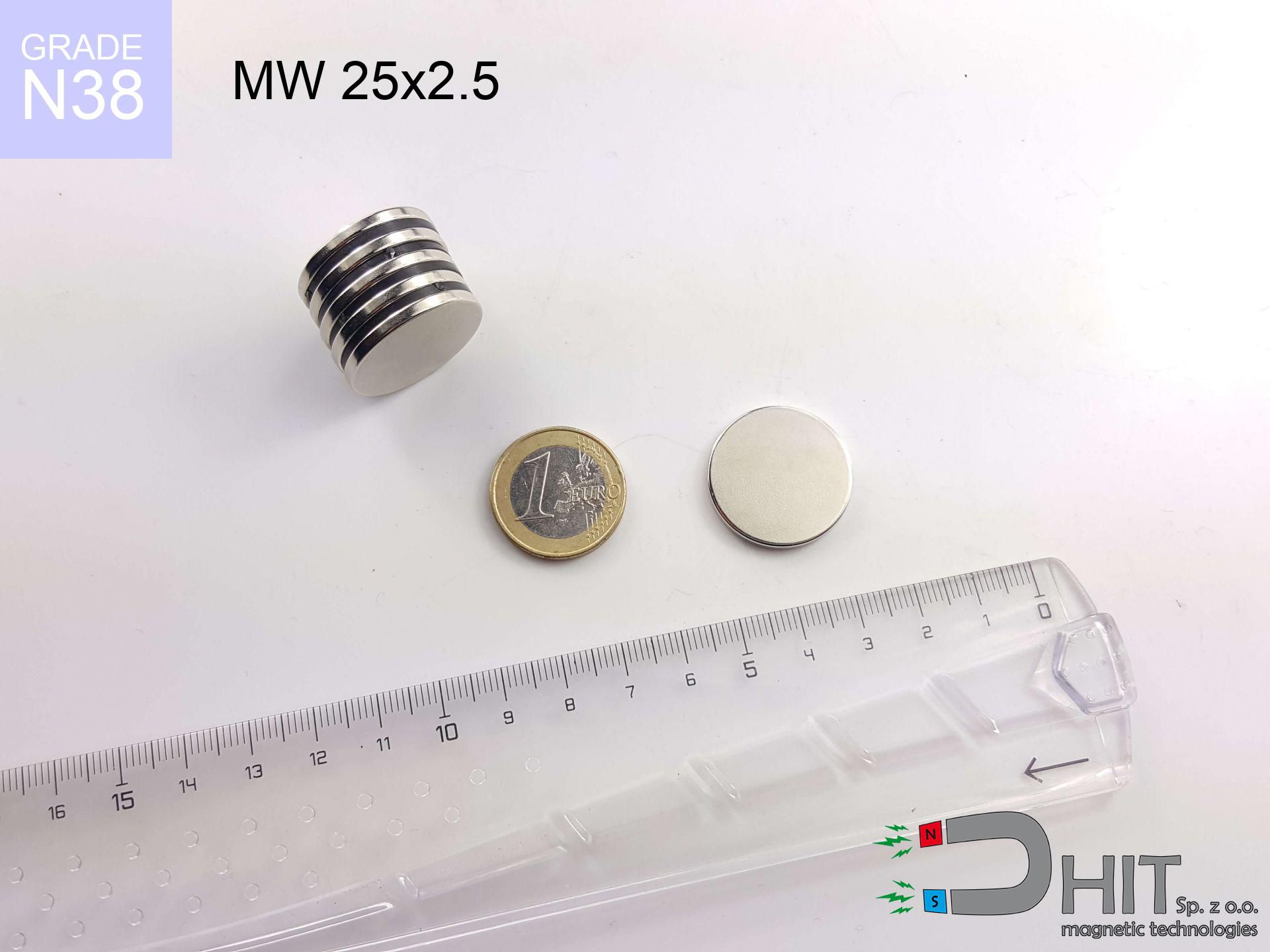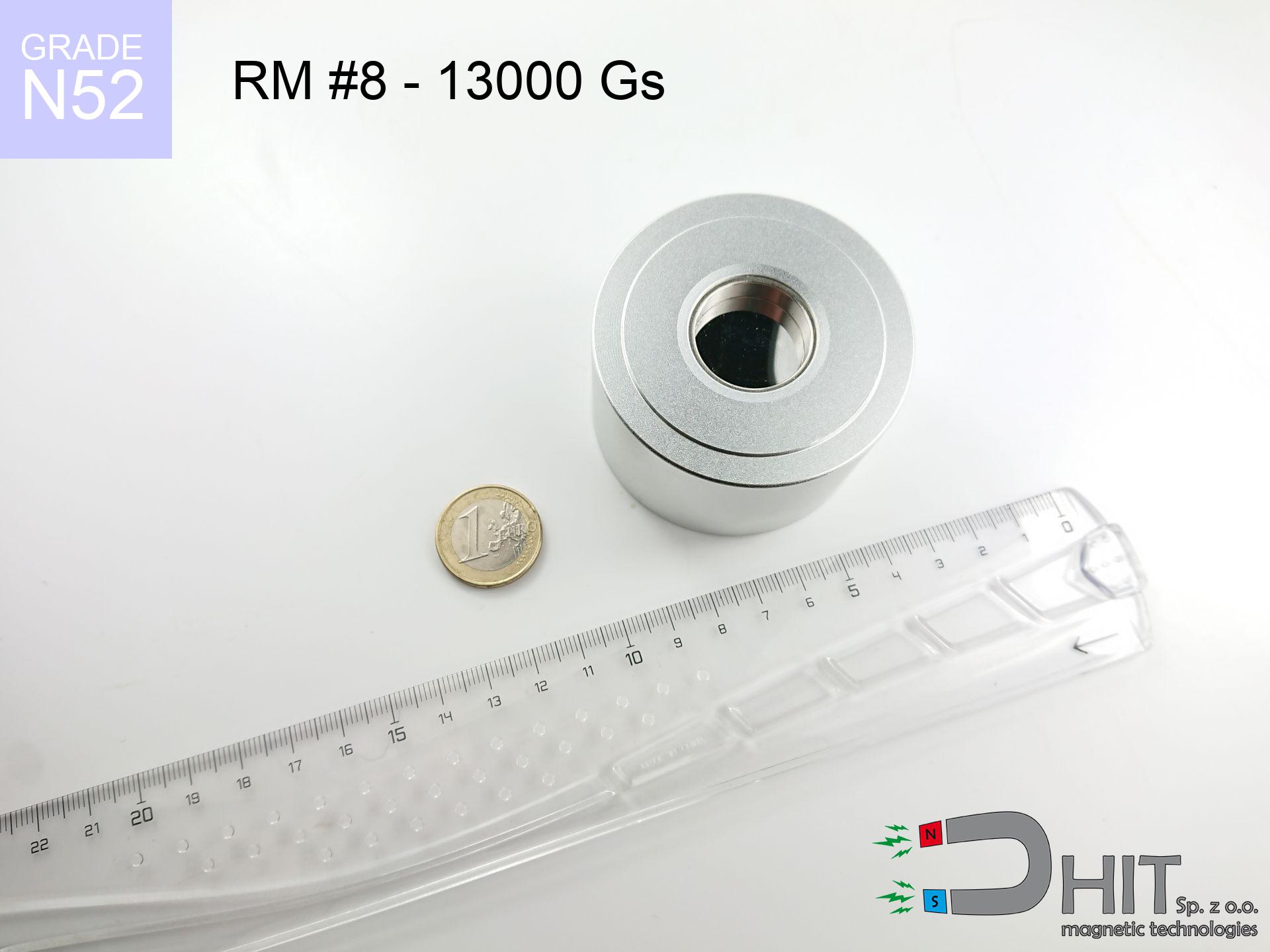SM 25x150 [2xM8] / N42 - magnetic separator
magnetic separator
Catalog no 130289
GTIN/EAN: 5906301812821
Diameter Ø
25 mm [±1 mm]
Height
150 mm [±1 mm]
Weight
560 g
Magnetic Flux
~ 6 500 Gauss [±5%]
393.60 ZŁ with VAT / pcs + price for transport
320.00 ZŁ net + 23% VAT / pcs
bulk discounts:
Need more?
Contact us by phone
+48 888 99 98 98
or send us a note through
inquiry form
the contact form page.
Weight along with form of a neodymium magnet can be calculated with our
our magnetic calculator.
Same-day processing for orders placed before 14:00.
Technical specification of the product - SM 25x150 [2xM8] / N42 - magnetic separator
Specification / characteristics - SM 25x150 [2xM8] / N42 - magnetic separator
| properties | values |
|---|---|
| Cat. no. | 130289 |
| GTIN/EAN | 5906301812821 |
| Production/Distribution | Dhit sp. z o.o. |
| Country of origin | Poland / China / Germany |
| Customs code | 85059029 |
| Diameter Ø | 25 mm [±1 mm] |
| Height | 150 mm [±1 mm] |
| Weight | 560 g |
| Material Type | Stainless steel AISI 304 / A2 |
| Magnetic Flux | ~ 6 500 Gauss [±5%] |
| Size/Mount Quantity | 2xM8 |
| Polarity | circumferential - 5 poles |
| Casing Tube Thickness | 1 mm |
| Manufacturing Tolerance | ±1 mm |
Magnetic properties of material N42
| properties | values | units |
|---|---|---|
| remenance Br [min. - max.] ? | 12.9-13.2 | kGs |
| remenance Br [min. - max.] ? | 1290-1320 | mT |
| coercivity bHc ? | 10.8-12.0 | kOe |
| coercivity bHc ? | 860-955 | kA/m |
| actual internal force iHc | ≥ 12 | kOe |
| actual internal force iHc | ≥ 955 | kA/m |
| energy density [min. - max.] ? | 40-42 | BH max MGOe |
| energy density [min. - max.] ? | 318-334 | BH max KJ/m |
| max. temperature ? | ≤ 80 | °C |
Physical properties of sintered neodymium magnets Nd2Fe14B at 20°C
| properties | values | units |
|---|---|---|
| Vickers hardness | ≥550 | Hv |
| Density | ≥7.4 | g/cm3 |
| Curie Temperature TC | 312 - 380 | °C |
| Curie Temperature TF | 593 - 716 | °F |
| Specific resistance | 150 | μΩ⋅cm |
| Bending strength | 250 | MPa |
| Compressive strength | 1000~1100 | MPa |
| Thermal expansion parallel (∥) to orientation (M) | (3-4) x 10-6 | °C-1 |
| Thermal expansion perpendicular (⊥) to orientation (M) | -(1-3) x 10-6 | °C-1 |
| Young's modulus | 1.7 x 104 | kg/mm² |
Table 1: Rod construction
SM 25x150 [2xM8] / N42
| Parameter | Value | Description / Unit |
|---|---|---|
| Diameter (Ø) | 25 | mm |
| Total length | 150 | mm (L) |
| Active length | 114 | mm |
| Section count | 4 | modules |
| Dead zone | 36 | mm (2x 18mm starter) |
| Weight (est.) | ~560 | g |
| Active area | 90 | cm² (Area) |
| Housing material | AISI 304 | 1.4301 (Inox) |
| Surface finish | Ra < 0.8 µm | Polished |
| Temp. class | 80°C | Standard (N) |
| Force loss (at max °C) | -12.8% | Reversible loss (physics) |
| Force (calculated) | 10.6 | kg (theor.) |
| Induction (surface) | ~6 500 | Gauss (Max) |
Chart 2: Field profile (4 sections)
Chart 3: Temperature performance
Chemical composition
| iron (Fe) | 64% – 68% |
| neodymium (Nd) | 29% – 32% |
| boron (B) | 1.1% – 1.2% |
| dysprosium (Dy) | 0.5% – 2.0% |
| coating (Ni-Cu-Ni) | < 0.05% |
Sustainability
| recyclability (EoL) | 100% |
| recycled raw materials | ~10% (pre-cons) |
| carbon footprint | low / zredukowany |
| waste code (EWC) | 16 02 16 |
Other deals
Advantages as well as disadvantages of neodymium magnets.
Strengths
- They do not lose power, even during nearly 10 years – the reduction in lifting capacity is only ~1% (according to tests),
- They are resistant to demagnetization induced by external field influence,
- Thanks to the metallic finish, the layer of Ni-Cu-Ni, gold, or silver-plated gives an professional appearance,
- Neodymium magnets deliver maximum magnetic induction on a contact point, which ensures high operational effectiveness,
- Neodymium magnets are characterized by very high magnetic induction on the magnet surface and can work (depending on the shape) even at a temperature of 230°C or more...
- Due to the option of precise shaping and customization to unique requirements, magnetic components can be created in a wide range of geometric configurations, which expands the range of possible applications,
- Fundamental importance in innovative solutions – they are utilized in hard drives, drive modules, medical devices, and technologically advanced constructions.
- Thanks to concentrated force, small magnets offer high operating force, occupying minimum space,
Cons
- To avoid cracks upon strong impacts, we suggest using special steel holders. Such a solution secures the magnet and simultaneously improves its durability.
- We warn that neodymium magnets can reduce their strength at high temperatures. To prevent this, we advise our specialized [AH] magnets, which work effectively even at 230°C.
- Due to the susceptibility of magnets to corrosion in a humid environment, we suggest using waterproof magnets made of rubber, plastic or other material immune to moisture, when using outdoors
- Due to limitations in realizing nuts and complicated forms in magnets, we recommend using a housing - magnetic mount.
- Potential hazard to health – tiny shards of magnets can be dangerous, if swallowed, which gains importance in the aspect of protecting the youngest. Additionally, tiny parts of these products are able to complicate diagnosis medical in case of swallowing.
- High unit price – neodymium magnets have a higher price than other types of magnets (e.g. ferrite), which can limit application in large quantities
Lifting parameters
Breakaway strength of the magnet in ideal conditions – what contributes to it?
- on a plate made of structural steel, perfectly concentrating the magnetic flux
- possessing a thickness of minimum 10 mm to avoid saturation
- with an ground contact surface
- with total lack of distance (without impurities)
- during detachment in a direction perpendicular to the plane
- at conditions approx. 20°C
Lifting capacity in real conditions – factors
- Space between magnet and steel – even a fraction of a millimeter of separation (caused e.g. by varnish or unevenness) diminishes the magnet efficiency, often by half at just 0.5 mm.
- Angle of force application – maximum parameter is obtained only during pulling at a 90° angle. The resistance to sliding of the magnet along the plate is standardly several times smaller (approx. 1/5 of the lifting capacity).
- Element thickness – to utilize 100% power, the steel must be adequately massive. Paper-thin metal restricts the attraction force (the magnet "punches through" it).
- Metal type – different alloys attracts identically. High carbon content weaken the interaction with the magnet.
- Surface condition – ground elements ensure maximum contact, which improves force. Rough surfaces weaken the grip.
- Thermal environment – temperature increase results in weakening of force. Check the thermal limit for a given model.
Holding force was checked on a smooth steel plate of 20 mm thickness, when the force acted perpendicularly, however under shearing force the lifting capacity is smaller. Additionally, even a small distance between the magnet’s surface and the plate decreases the holding force.
Safe handling of NdFeB magnets
Threat to electronics
Device Safety: Strong magnets can damage data carriers and sensitive devices (heart implants, medical aids, mechanical watches).
Swallowing risk
Absolutely keep magnets out of reach of children. Risk of swallowing is significant, and the effects of magnets connecting inside the body are life-threatening.
Do not drill into magnets
Dust generated during machining of magnets is combustible. Do not drill into magnets unless you are an expert.
Finger safety
Pinching hazard: The attraction force is so immense that it can cause hematomas, pinching, and broken bones. Protective gloves are recommended.
Caution required
Handle with care. Rare earth magnets act from a distance and snap with massive power, often quicker than you can react.
GPS and phone interference
A strong magnetic field negatively affects the operation of compasses in smartphones and navigation systems. Maintain magnets near a smartphone to avoid breaking the sensors.
Risk of cracking
Neodymium magnets are sintered ceramics, which means they are very brittle. Collision of two magnets leads to them cracking into small pieces.
Nickel allergy
Certain individuals suffer from a hypersensitivity to nickel, which is the standard coating for neodymium magnets. Prolonged contact may cause a rash. We strongly advise wear safety gloves.
Danger to pacemakers
Warning for patients: Strong magnetic fields disrupt medical devices. Maintain minimum 30 cm distance or ask another person to handle the magnets.
Heat sensitivity
Monitor thermal conditions. Heating the magnet to high heat will ruin its magnetic structure and strength.

![Separation magnetic rod SM 25x150 [2xM8] / N42 Separation magnetic rod SM 25x150 [2xM8] / N42](https://cdn3.dhit.pl/graphics/banners/magnet.webp)
![SM 25x150 [2xM8] / N42 - magnetic separator](https://cdn3.dhit.pl/graphics/products/sm-25x150-2xm8-cim.jpg)


![SM 25x200 [2xM8] / N52 - magnetic separator SM 25x200 [2xM8] / N52 - magnetic separator](https://cdn3.dhit.pl/graphics/products/sm-25x200-2xm8-jas.jpg)

